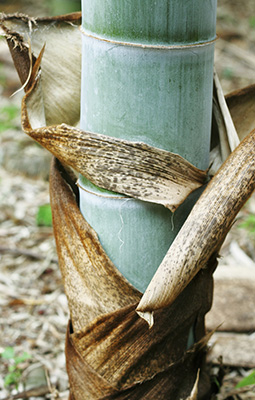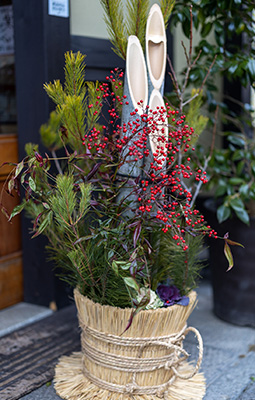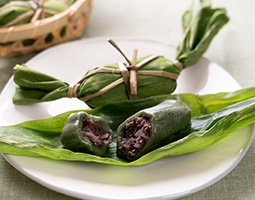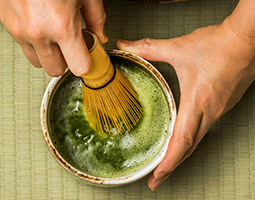August 2022
- English
- 日本語
The Characteristics and Many Uses of Japanese Bamboo

Shibata Shozo, a professor at Kyoto University 
To fly a taketombo (bamboo dragonfly), the shaft of the propeller is placed between the palms of both hands and the palms are rubbed together to rotate the blades as the shaft is released with an upward throwing motion.

The culm sheath (protective covering for the culm, or stem, of bamboo) falls off as the plant grows. 
Kadomatsu (gate pine), a popular New Year’s decoration made mostly of pine and bamboo 
Sasa-dango dumplings wrapped in sasa bamboo leaves 
Hot water and matcha tea are mixed in a tea bowl using a bamboo tea whisk in the tea ceremony

We spoke with Shibata Shozo, a professor at Kyoto University and Chief Director of the Japan Bamboo Society, about the characteristics of Japanese bamboo and its many different uses.

How many species of bamboo grow in Japan, and what are their characteristics?
It is estimated that there are more than 1,200 species of bamboo worldwide, of which around 250 grow in Japan. The species found in Japan are divided into two main types: sasa and bamboo (take in Japanese). The two species can be roughly distinguished by their height and the culm sheath (protective covering) on the stem, known as a culm. Sasa grows to a height of 0.5 to 4 meters and its culm sheath remains on the culm while growing. On the other hand, bamboo can reach nearly 20 meters in height and its culm sheath falls off as it grows.
The most common varieties of bamboo in Japan are mosochiku, madake and hachiku. Mosochiku was introduced from China around five hundred years ago. Many of the bamboo shoots that are known as the taste of spring (see here) are mosochiku. Madake and hachiku are believed to have been native to Japan since prehistoric times and have been used in many different applications since long ago, including utensils, ornaments, and for constructing buildings.
A characteristic feature of bamboo is that the culm is divided into nodes, and the spaces between the nodes are hollow. Also, the bamboo shoot has a rapid growth rate, with some records showing around 120 centimeters of growth in a single day. Another characteristic is its subterranean stem called a rhizome, which extends underground like a root. Rhizomes grow horizontally below the surface of the soil at a depth of tens of centimeters. Every year, bamboo shoots emerge from the underground rhizomes and then grow to form new culms. Although a Japanese bamboo forest appears to consist of individual bamboo culms, many have grown from the same rhizome.
About when did Japanese people first start using bamboo?
It is not exactly clear, but its use is thought to date back at least to the late Jomon period (around 2,900 to 3,200 years ago), since rantai shikki baskets* made of woven sasa and coated with lacquer have been excavated from Jomon ruins.
There is evidence in early Japanese chronicles that points to a connection between Japanese people and bamboo. The Kojiki, compiled in the early 8th century, tells of a myth that the deity Izanagi no Mikoto broke off and threw a tooth of an ornamental bamboo comb he was wearing, which turned into an edible bamboo shoot. This shows that bamboo was already being used as a fashion accessory and consumed as a food by this time.
Other evidence from historical sources is found in the oldest folk tale in Japan, Taketori Monogatari (The Tale of the Bamboo Cutter), believed to have been written in the early Heian period (late 8th to late 12th century). The tale is about a young lady named Kaguya-hime who was discovered inside a bamboo culm. At the beginning of the story, we learn that an old bamboo cutter called Taketori no Okina who discovers Kaguya-hime “gathers bamboo from the mountains and fields and makes different things from it.” This suggests that during the Heian period people gathered bamboo from the mountains and fields and used it in their daily lives.
How have Japanese people used bamboo?
Japanese people have used bamboo for many different purposes. Bamboo is evergreen so both its culms and leaves remain green even in winter. People therefore associated bamboo with a sense of permanence and came to regard it as a sacred plant. Because of this, bamboo is used for decorations at annual festivals and ceremonial rituals. The most familiar example is the kadomatsu (gate pine). The kadomatsu is a New Year’s decoration made mostly of bamboo and pine, another evergreen tree, that is placed at the gates and entrances of homes and other buildings at this time of year. It is displayed to guide the deities who are said to visit each home on the first day of the new year.

Another way that bamboo is used is in the ritual of jichinsai, or ground-breaking ceremony, commonly performed at construction sites before building work begins to offer prayers to the guardian deities of the land for the safe completion of the work. At that time, an altar is erected within a square enclosure demarcated by four bamboo poles with leaves. The meaning of this is to use sacred bamboo to create a sanctuary into which the deities are invited.
Bamboo is lightweight, easy to cut, very flexible, and doesn’t break easily when bent. By taking advantage of these characteristics many items are made from bamboo. For example, in the past bamboo was used to make weapons such as bows and arrows. Even now we can see bamboo used for daily necessities such as baskets, colanders, brooms, umbrellas and chopsticks, as well as fishing rods and other fishing tackle, and as a construction material for houses. Besides, bamboo leaves and the sheath of the culms have antibacterial properties and are sometimes used to wrap foods such as onigiri (rice balls) and dango (dumplings).

One of the Japanese cultural traditions most closely associated with bamboo is the tea ceremony. Here, bamboo is used for everything from the construction of tea rooms to tea utensils. A bamboo utensil that I consider unique is tea whisk** used to mix the hot water and matcha in the tea bowl. Tea whisks are made by splitting madake or hachiku into slender prongs. This innovative design is made possible only by bamboo.

How have bamboo forests been utilized in Japan?
Bamboo’s spreading rhizome system anchors the soil, helping to prevent damage from natural disaster. Before the spread of civil engineering technology from the West during the Meiji period (1868–1912), bamboo was planted along reservoir embankments and riverbanks. Also, being less prone to ground collapse due to their rhizomes, bamboo forests have long been said throughout Japan to be a safe place to take shelter during an earthquake.
Thus, as well as the application of bamboo as a material, bamboo forests themselves served a very useful purpose. That is why bamboo forests were located close to human settlements. However, the 1960s onward have seen the demand for bamboo decline due to factors such as the widespread use of plastic products. And urbanization has led to an increase in the number of bamboo forests that have fallen into disuse.
It is important that bamboo is cut down regularly to ensure that forests do not become overgrown. The way I describe the ideal density of bamboo is that it should be enough to allow a person holding an umbrella to walk through without the umbrella coming in contact with the bamboo. This level of density enables sufficient sunlight to penetrate the forest for the bamboo to thrive, producing forests that are a source of tasty bamboo shoots as well as craft and building materials. The young rhizomes also spread properly, enhancing disaster prevention function.
Amid growing public attention to the Sustainable Development Goals (SDGs) and plastic waste, bamboo has been gaining prominence as a sustainable resource in recent years. Local governments and NPOs are working with residents to manage and utilize neglected bamboo forests, while companies are developing new effective ways to use bamboo.
What are some of the non-traditional ways in which bamboo is being used today?
Many different companies are using bamboo powder, fiber, or extract in their products. For instance, due to bamboo’s rich fiber content, its powder is added to foods such as pasta and bread. Bamboo fiber is also used to make towels that are highly absorbent, odor-resistant, and soft to the touch. And bamboo vinegar extracted by allowing the steam and smoke produced when making bamboo charcoal to cool is used as an insect repellent for agricultural crops and as a cleaning agent.
A cutting-edge material made from bamboo is cellulose nanofiber (CNF)***. CNF is a fiber manufactured from cellulose, a major component of plants, which has been micro-refined to the nano level (one nanometer equals a billionth of a meter). CNF is lightweight and strong, and is resistant to warping when exposed to heat. Research and development efforts are currently underway to manufacture CNF from bamboo for utilization in applications such as buildings and satellite components.
Bamboo is an excellent material. As more people become aware of the superior benefits of bamboo, new applications will likely be developed.
Once the spread of COVID-19 subsides, what kind of Japanese bamboo would you like visitors from overseas to see in Japan?
One place that I would really like them to see is the Arashiyama bamboo forest in Kyoto (see here). Well-managed bamboo forests offer stunning scenery. Most species of bamboo grow in the tropics and subtropics, with just a few species able to survive in colder climates. These can only be found in Japan and elsewhere in East Asia and in mountainous areas such as the Himalayas and the Andes. Many people overseas think of bamboo as a plant that grows in hot climates, so when they visit Japan, the sight of a winter landscape featuring green bamboo forest against white snow will surely make a strong impact.
I also think it would be fun for visitors to try their hand at making bamboo crafts. One of the most well-known places for bamboo crafts in Japan is Beppu City, Oita Prefecture****. Here, there are schools that teach bamboo crafts as well as workshops where participants can try their hand at crafting items from bamboo.
Once, taketombo (bamboo dragonfly, also known as a bamboo-copter), a traditional Japanese bamboo toy, were handed out at an international conference on bamboo held overseas. A taketombo is a piece of bamboo carved in the shape of a propeller with a thin shaft attached. To fly it, the shaft is placed between the palms of both hands and the palms rubbed together to rotate the blades as the shaft is released with an upward throwing motion. The taketombo was a big hit with the conference participants, who became quite absorbed in making it fly.

I would like to continue disseminating information in Japan and overseas about the multi-faceted appeal and potential of bamboo.
* See Highlighting Japan May 2022, “Red Lacquerware from the Jomon Period” https://www.gov-online.go.jp/eng/publicity/book/hlj/html/202205/202205_04_en.html
** See Highlighting Japan July 2016, “The Way of Whisks” https://www.gov-online.go.jp/eng/publicity/book/hlj/html/201607/201607_12_en.html
*** See Highlighting Japan September 2016, “Knock on Wood” https://www.gov-online.go.jp/eng/publicity/book/hlj/html/201609/201609_09_en.html
**** See Highlighting Japan October 2016, “The Old Bamboo” https://www.gov-online.go.jp/eng/publicity/book/hlj/html/201610/201610_12_en.html

